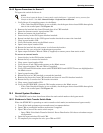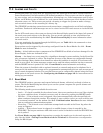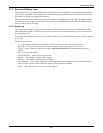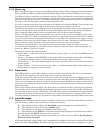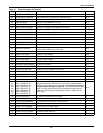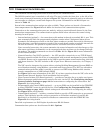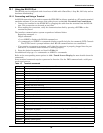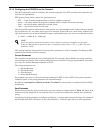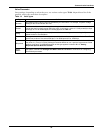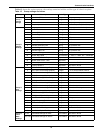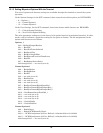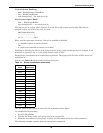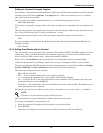
Communication Interfaces
87
12.0 COMMUNICATION INTERFACES
The STS2/PDU monitoring system offers several choices for communications.
The RS-232 terminal port is standard on all units. The port is inside the front door, to the left of the
touch screen front panel mounting as shown in Figure 55. This port is primarily used as an alternate
user interface to configure, control and diagnose the system. Commands for the RS-232 port are
shown in Table 13.
Several other communications options are also available. Those options are located a Communica-
tions compartment. See Figures 47 and 48 for the location of the communications options.
Connections to the communication ports are made by wiring to terminal boards located in the Com-
munications compartment. The communications options listed below reference the control wiring
drawing for each option.
• Internal modem (optional) — the connection to this modem is through a standard RJ-11 port. This
port automatically dials the programmed telephone number when a designated alarm occurs.
Automatic dial attempts are made to the first phone number at periodic intervals for 30 minutes.
After that time, auto dial attempts are made to the second phone number at periodic intervals for
the next 30 minutes. The process is repeated until a successful connection is made.
Upon successful connection, the system transmits the status information and then hangs up. Sys-
tem status and history information can be requested and date and time can be changed through
the modem. The modem commands are shown in Table 13. See Figure 53 for more information
on the internal modem.
• Network Interface Card (NIC) (optional) — the NIC provides connectivity to any TCP/IP-based
Ethernet network to allow the device to communicate with network management systems (NMS)
via SNMP. Events can be transmitted to the NMS to provide remote status monitoring, plus fault
and alarm detection. The NIC includes an RJ-45 port for an Ethernet connection, via Category 5
cable.
The NIC can also integrate the system with an existing Building Management System (BMS) or
out-of-band monitoring, using Modbus, a standard multi-drop protocol. The NIC has redundant
communication paths that make it possible to connect to a BMS using Modbus while simulta-
neously communicate to a NMS through SNMP
See Figure 54 for more information on the NIC. If you have questions about the NIC, refer to the
OpenComms Network Interface Card installation and user guide.
• Input Contact Isolator (ICI) Board (optional) — provides an interface for up to eight user inputs.
External messages and alarms can be routed to the unit, via the ICI. See Configuring the Input
Contact Isolator Settings on page 108 for instructions on configuring the connections. See
Figure 51 for wiring details.
• Programmable relay board (PRB) (optional) — up to two PRBs can be installed in the STS2/PDU
to route STS2/PDU events to external devices. See Configuring the Programmable Relay
Board Settings on page 109 for default settings and instructions for reconfiguring the relays.
See Figure 50 for wiring details.
• Comms Board (optional) — includes a terminal block to provide a DTE connection to an external
modem. This board also provides a direct connection to a SiteScan terminal, via an RS-422.
SiteLink-12 or SiteLink-4 is required for SiteScan to communicate with the STS2/PDU. See
Figure 52 for wiring details.
Data link requirements are Full Duplex Asynchronous RS-232 format.
Communications options are also discussed in 6.0 - Options.




